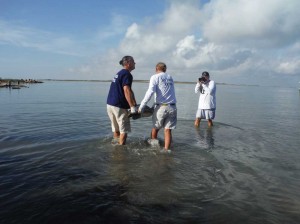Because natural gas burns two times cleaner than coal, and because LNG shipped overseas would be used in place of coal to fire power plants, in many cases, the U.S. Department of Energy predicts that LNG production could reduce global greenhouse gases, long-term, by 15 to 30 percent, even when the dirty factors of the shale industry are figured in.
“Such factors — compared with the prospects of frying the planet — are either exaggerated or situations which can be controlled,” explained Eric Ellman, communications director for Yale Climate and Energy Institute. His perspective reflects the positions of most academic and political organizations that are framing the carbon-fuel discussion and influencing the Energy Department, which is steadily but surely issuing permits to allow LNG shipment, mostly from Texas ports.
When natural gas is converted to liquid, however, the environmental benefits of this cleaner-burning fuel are undermined.
In addition to the destructive effects of methane leaks in the gas drilling process, the pollution that results from converting natural gas to liquid makes it, ultimately, nearly as destructive to the air as coal and possibly more so. Because gas drilling, fracking, and disposal of drilling wastes can severely damage the water table, and because LNG processing is dangerous to coastal estuaries, investing public resources to promote LNG as a solution to global warming seems short-sighted, to say the least — especially if it slows down the conversion of industries to renewable, nonpolluting sources like wind and solar power.
********
The dolphins are swimming alongside my neon-orange kayak, as if offering a guided escort, when one twice the size of those near me shoots out of the water, airborne. This bullish dolphin seems more like a whale, a good 15 feet in length and a thousand or so pounds in weight. Its tail splashes water with a sound like thunder when the mammoth falls, a message perhaps to the smaller dolphins to leave me alone, which they do, and probably a message to me, too.
The message may already be too late, given the political support for LNG production and the fact that 10 years of planning has already gone into the plants slated to be built here. Though no ground has been broken in Brownsville for LNG site construction, deals for infrastructure have been inked, and large companies are buying smaller ones that have made more progress in permitting.

An industrywide trend is driving LNG facilities into remote coastal zones: There’s not enough room for these facilities at most of the nation’s larger ports, and if there’s room, the space is prohibitively expensive. As a result, LNG companies are setting up shop at smaller, more rural ports throughout the United States.
It’s hard to imagine how one industry could cause a 20 percent increase in the carbon monoxide emissions of a region of nearly a million people. But those are the projections in the lower Rio Grande Valley if the Brownsville Navigation District manages to facilitate construction of LNG conversion plants.
In a half-dozen stories on the LNG projects published by The Brownsville Herald in the last year, none has mentioned the potential negative effects of the industry, although a quick Google search reveals plenty of information about the dangers of LNG and story after story of community groups that have organized against it.
In South Texas, too, a sizable group of residents have organized to raise awareness about the dangers of LNG. Save RGV from LNG is a hodge-podge of community activists who’ve figured out exactly how dangerous that industry might be to their region.
About 50 people convene at the group’s monthly gatherings, and about 300 have attended their events, mostly presentations outlining the threat LNG poses to the Rio Grande Valley’s environment and tourism. So far, none of the local chambers of commerce or economic development corporations has joined the effort, though they all promote the region’s clean air, clean water, and nature-tourism opportunities.
No Rio Grande Valley politician has joined the group either, but at least 29 South Texas elected officials and community leaders have sent letters to the FERC supporting LNG.
The port of Brownsville is home to a fledgling fleet of shrimp boats and a branch of a multinational corporation that builds deep-water oil rigs and other large-scale projects. Agriculture is dwindling in South Texas, and a few call centers are located there. Beyond those and the educational and healthcare systems common to any metropolitan zone, there really aren’t any unique industries besides nature and tourism.
Fort Worth Weekly asked Eduardo Campirano, chief executive officer of the Port of Brownsville, about the potential effects of LNG-related pollution on the Valley’s tourism. At least 15 times in a 72-minute interview, Campirano turned aside those questions by saying that the five LNG companies that are already renting space at the port might not end up operating at all.
Bill Harris, a spokesperson for Exelon, a multinational natural gas company with a major presence in Fort Worth and an interest in Brownsville LNG development, had the same reaction. Asked to comment on the effects of LNG-related pollution on the Valley’s tourism industry, he said that shipment of LNG from Brownsville by his company is just a possibility that, even if it happens, wouldn’t begin for years.
The Brownsville Public Utilities Board has remained almost completely silent on questions concerning the extent of its efforts to promote LNG, fighting public information requests for information on who would benefit from some of its investments and which landowners will benefit from lease agreements needed to build a 50-mile natural gas pipeline stretching from the King Ranch to the port.
But in industry press releases and Brownsville Herald articles, many of those who refused to comment to the Weekly have cheered for LNG development and are spending public money full-force on construction projects to make that industry a reality.
********
Kayaking the hyper-saline bay that separates Port Isabel and the Brownsville port, I’m polka-dotted with shadow from soaring brown pelicans, their wingspans broader than my outstretched arms. Thirteen of them fly a few yards above me, patterned in a V like migrating geese.
They bank slowly and effortlessly toward the Gulf of Mexico. In the near distance, about a half-mile ahead, is the future site of the northernmost LNG terminal planned for the Brownsville port. It’s on the coastal side of a deep-water channel edged by sand outcroppings rarely touched by man or human interests, except for the occasional angler hoping to snag a fighter. Snook, redfish, mackerel, tarpon, trout, black-tip shark … the list of fish varieties goes on and on here near the mouth of this federally protected area known as South Bay.
Soon the pelicans return, and I’m under their shadow again. Will they stay if LNG booms along this bay?
Freelance writer David Robledo’s work has appeared in South Texas Nation magazine and elsewhere. He can be reached at southtexasnation@gmail.com.












Thank you for publishing an extraordinarily reported story. The silence of those who stand to profit is ominous; the voice of the reporter is appreciated.
Great piece of story-telling and truth-telling. If we let the vested (and monied) interests have their way, no one will be able to say we didn’t know what was coming. Thanks for keeping this in front of us — time for everyone to step up …
Well put Mr. Robledo. Southern most TX coast should be left as is. Nature and the citizens of that precious area deserve to have their land safe from false hopes of a damaging industry.
Well put Mr. Robledo. The southern most TX coast should be left as is. Nature and the citizens of that precious area deserve to have their land safe from false hopes of a damaging industry.
In Louisiana, China bypassed the system by taking natural gas used to make methanol and then “that” gets shipped overseas to make plastic trinkets. Other companies are also ramping up our “abundant” (for now!) resources to make and export things like fertilizer. BASF has a project in the works..read about it here….http://barnettshalehell.wordpress.com/?s=methanol
Great article! Having LNG in the RGV would be investing in a horrible future. Development must not kill the economic sources we already have–recreation and nature tourism. More local news sources need to be reporting on more than what politicians and the LNG companies say.
Well written and very informative. Thank you for writing about this.